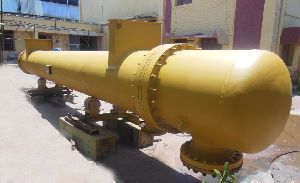
Vertical Shell And Tube Heat Exchanger
A vertical shell and tube heat exchanger in which the tubes extend through oversized holes in a liquid distribution plate. Liquid flows through the holes and down each tube exterior surface as a falling film. A spacer or clip, desirably of wire, is placed in each hole around each tube to center the tube so that the film has a uniform thickness. The clip is self-locking and remains fixed securely in position. Vertical Shell and Tube Heat Exchanger is a heat exchanger that is derived from its parent Shell and Tube Heat Exchanger and it is most commonly all Industries which involves higher-pressure and Higher Temperature applications. A set of tubes is called the tube bundle and can be made up of several types of tubes: plain, longitudinally finned, etc. Shell and tube heat exchangers are typically used for high-pressure applications (with pressures greater than 30 bar and temperatures greater than 260 °C).[2] This is because the shell and tube heat exchangers are robust due to their shape. Specifications : Vertical Shell and tube heat exchangers consist of a series of tubes. One set of these tubes contains the fluid that must be either heated or cooled. The second fluid runs over the tubes that are being heated or cooled so that it can either provide the heat or absorb the heat required. Applications : Vertical Shell Tube Heat Exchanger is widely used in variety of application as a cooling solution. The most common amoung them is for cooling of Hydraulic Fluid and oil in engines, transmissions and hydraulic power packs. With the right coimbination of materials they can also be used to cool or heat other mediums, such as swimming pool water or charge air. Vertical Shell Tube Heat Exchanger also be used on fixed tube sheet heat exchangers Advantages : They are commonly used in space heating refrigeration air conditioning power plants chemical plants petrochemical plants petroleum refineries natural gas processing sewage treatment
...more
U Tube Bundle Heat Exchanger
A heat-exchanger system consisting of a bundle of U tubes (hairpin tubes) surrounded by a shell (outer vessel); one fluid flows through the tubes, and the other fluid flows through the shell, around the tubes.Multitherm can duplicate any existing bundle to include dimensions, materials and performance. we can build “U” tube bundles, straight tube “floating” tube bundles, or we can retube fixed tubesheet heat exchangers when the bundles is not removable. multitherm is not locked into any one material. Most bundles tend to be build with copper tubes and steel tubesheets In nuclear power plants called pressurized water reactors, large heat exchangers called steam generators are two-phase, shell-and-tube heat exchangers which typically have U-tubes. They are used to boil water recycled from a surface condenser into steam to drive a turbine to produce power. Most shell-and-tube heat exchangers are either 1, 2, or 4 pass designs on the tube side. Specifications : The number of times the fluid in the tubes passes through the fluid in the shell. In a single pass heat exchanger, the fluid goes in one end of each tube and out the other. A tube bundle heat exchanger with baffles is disclosed wherein a tube bundle is housed within an inner casing which is acted upon from both the inside and the outside by a heating medium Applications : The simple design of a shell and tube heat exchanger makes it an ideal cooling solution for a wide variety of applications. One of the most common applications is the cooling of Hydraulic Fluid and oil in engines, transmissions and hydraulic power packs. With the right choice of materials they can also be used to cool or heat other mediums, such as swimming pool water or charge air. Advantages : Advantages of using a heat exchanger is that they are often easy to service. Particularly with models where a floating tube bundle where the tube plates are not welded to the outer shell is available. Fixed tube sheet heat exchangers.
...more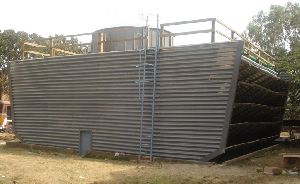
timber cooling towers
Timber Cooling Towers are useful for air conditioning plants, induction furnace, injection moulding machine, chemical plants, chilling plants, oxygen plants and also for steel industries, cement industries and chemical industries. These depends upon the site condition you can prepare the model of the tower. It can be used for which quantity of water-cooling by extending the size, then lengths by increasing the Standard Size Pressure treated wooden Frames. The woods used for manufacturing the Cooling Towers are completely seasoned chemically treated, lightwood. The Drift Eliminator, Fan duct, Splash bars and complete Structures are made out of the same wood. Specifications Timber Cooling Towers are nothing then water is cooled with natural atmospheric air traveling and the water is sprayed with the help of Spray nozzles. Applications : The common Timber type Cooling Towers required by all the major sector customers. These Cooling Towers are having mechanical Fan and the water is cooled with the help of mechanical Fan motor. Cooling towers provides better thermal performance, low drift loss suitable for the current water scarced world. Advantages : The main advantage of Timber cooling towers are energy saving through these system.
...more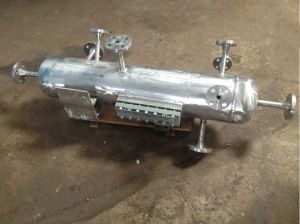
SS High Pressure Heat Exchangers
SS High Pressure Heat Exchanger is use of pipes or other containment vessels to heat or cool one fluid by transferring heat between it and another fluid. The walls of the pipe are usually made of metal. The exchanger consists of a coiled pipe containing one fluid that passes through a chamber containing another fluid. Another substance with a high thermal conductivity, to facilitate the interchange, The outer casing of the larger chamber is made of a plastic or coated with thermal insulation, to discourage heat from escaping from the exchanger. Specifications SS High Pressure Heat Exchangers are pressed to form troughs at right angles to the direction of flow of the liquid which runs through the channels in the heat exchanger. Applications : SS High Pressure Heat Exchangers are often spaced by rubber sealing and gaskets which are cemented into a section around the edge of the plates. Advantages : SS High Pressure Heat Exchangers are compressed together in a rigid frame to form an arrangement of parallel flow channels with alternating hot and cold fluids.
...more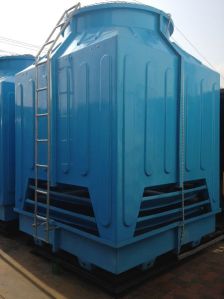
Square Cooling Tower
Square Shaped Cooling Tower[/caption]Square shape cooling tower is a design in which the air flow is directed perpendicular to the water flow (see diagram below). Air flow enters one or more vertical faces of the cooling tower to meet the fill material. Water flows (perpendicular to the air) through the fill by gravity. the air flow is directly opposite to the water flow (see diagram below). Air flow first enters an open area beneath the fill media, and is then drawn up vertically. The water is sprayed through pressurized nozzles near the top of the tower, and then flows downward through the fill, opposite to the air flow. The cool water absorbs heat from the hot process streams which need to be cooled or condensed, and the absorbed heat warms the circulating water. The warm water returns to the top of the cooling tower and trickles downward over the fill material inside the tower. Square shape cooling tower contacts ambient air rising up through the tower either by natural draft or by forced draft using large fans in the tower. That contact causes a small amount of the water to be lost as windage (W) and some of the water (E) to evaporate. This method works on the principle that continuous particle removal will keep the system clean. Manufacturers typically package side-stream filters on a skid, complete with a pump and controls. For high flow systems, this method is cost-effective. Properly sizing a side-stream filtration system is critical to obtain satisfactory filter performance.
...more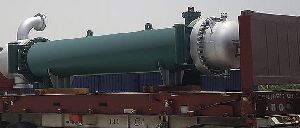
Shell and Tube Heat Exchanger
Shell and Tube Heat Exchanger is the most common type of heat exchanger in oil refineries and other large chemical processes, and is suited for higher-pressure applications. Shell Tubes Heat Exchanger are classified into fixed and Floating type Heat Exchangers . Fixed type Heat Exchangers are used where there are absolutely no chances for inter mixing of two fluids. Shell and tube heat exchangers consist of a series of tubes. One set of these tubes contains the fluid that must be either heated or cooled. The second fluid runs over the tubes that are being heated or cooled so that it can either provide the heat or absorb the heat required. In this type, the tube sheets are completely welded to the shell and acted as shell flanges. The Floating type Heat Exchangers has the advantages of removability of tube bundle and access for cleaning both inner and outer side of tubes and shell. Specifications Shell Tube Heat Exchanger stream a process fluid and other cooling water or air. This is an efficient way to conserve energy. Two-phase heat exchangers can be used to heat a liquid to boil it into a gas Applications : Shell Tube Heat Exchanger is widely used in variety of application as a cooling solution. The most common amoung them is for cooling of Hydraulic Fluid and oil in engines, transmissions and hydraulic power packs. With the right coimbination of materials they can also be used to cool or heat other mediums, such as swimming pool water or charge air. One of the big advantages of using a shell and tube heat exchanger is that they are often easy to service, particularly with models where a floating tube bundle (where the tube plates are not welded to the outer shell) is available. Can also be used on fixed tube sheet heat exchangers space heating refrigeration air conditioning power plants chemical plants petrochemical plants petroleum refineries natural gas processing sewage treatment Advantages : Shell Tube Heat Exchanger is often easy to service, particularly with models.
...more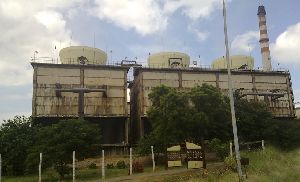
Rcc Cooling Tower
RCC Construction also both in Cross Flow and Counter Flow design. The structure of Cooling Tower is complete with RCC, the tower life will be more than timber as well as FRP and higher capacities are available in multi cell construction. Specifications United Cooling Towers offer a high quality RCC Cooling Towers which are used in various industries. Our RCC Cooling Towers have the following specifications: Type : Both Cross and Counter flow Fan Cylinder : RCC Construction Gear Box : Spiral Bevel type Gear. End wall Casing & Louver : RCC Construction. Drive Shaft : Tubular type single span drive shaft fitted with flexible coupling with bushes at both end. Drive shafts are made of MS with HDG / SS for special case. Applications : RCC cooling towers or cement prices are higher at a site to opt for cheaper natural draft cooling towers made of structural steel. Advantages : RCC cooling tower is also used as a industrial chimney, thus saving the cost of a separate chimney structure and plants without flue gas purification, problem with corrosion may occur, due to reactions of raw flue gas with water to form acids.
...more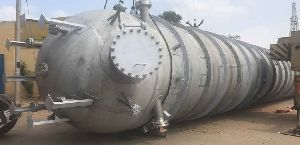
Pressure Vessel Heat Exchanger
A pressure vessel is a closed container designed to hold gases or liquids at a pressure substantially different from the ambient pressure. The pressure differential is dangerous and many fatal accidents have occurred in the history of pressure vessel development and operation. Consequently, pressure vessel design, manufacture, and operation are regulated by engineering authorities backed by legislation. For these reasons, the definition of a pressure vessel varies from country to country, but involves parameters such as maximum safe operating pressure and temperature. More complicated shapes have historically been much harder to analyze for safe operation and are usually far more difficult to construct. Theoretically, a spherical pressure vessel has approximately twice the strength of a cylindrical pressure vessel.[1] However, a spherical shape is difficult to manufacture, and therefore more expensive, so most pressure vessels are cylindrical with 2:1 semi-elliptical heads or end caps on each end. Smaller pressure vessels are assembled from a pipe and two covers. A disadvantage of these vessels is that greater breadths are more expensive, so that for example the most economic shape of a 1,000 litres (35 cu ft), 250 bars (3,600 psi) pressure vessel might be a breadth of 914.4 millimetres (36 in) and a width of 1,701.8 millimetres (67 in) including the 2:1 semi-elliptical domed end caps. Specifications : Pressure vessels can theoretically be almost any shape, but shapes made of sections of spheres, cylinders, and cones are usually employed. A common design is a cylinder with end caps called heads. Head shapes are frequently either hemispherical or dished (torispherical). Applications : Pressure vessels are diving cylinders, recompression chambers, distillation towers, autoclaves, and many other vessels in mining operations, oil refineries and petrochemical plants, nuclear reactor vessels, submarine and space ship habitats, pneumatic reservoirs, hydraulic reservoirs under pressure, rail vehicle airbrake reservoirs, road vehicle airbrake reservoirs, and storage vessels for liquified gases such as ammonia, chlorine, propane, butane, and LPG. Advantages : Pressure vessels are used in a variety of applications in both industry and the private sector. They appear in these sectors as industrial compressed air receivers and domestic hot water storage tanks.
...more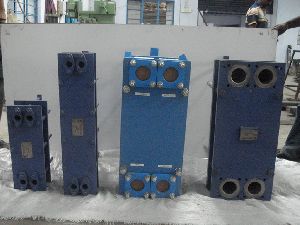
Plate Type Heat Exchanger
A plate type heat exchanger is a type of heat exchanger that uses metal plates to transfer heat between two fluids. This has a major advantage over a conventional heat exchanger in that the fluids are exposed to a much larger surface area because the fluids spread out over the plates. This facilitates the transfer of heat, and greatly increases the speed of the temperature change. It is not as common to see plate heat exchangers because they need well-sealed gaskets to prevent the fluids from escaping, although modern manufacturing processes have made them feasible. The concept behind a heat exchanger is the use of pipes or other containment vessels to heat or cool one fluid by transferring heat between it and another fluid. In most cases, the exchanger consists of a coiled pipe containing one fluid that passes through a chamber containing another fluid. The walls of the pipe are usually made of metal, or another substance with a high thermal conductivity, to facilitate the interchange, whereas the outer casing of the larger chamber is made of a plastic or coated with thermal insulation, to discourage heat from escaping from the exchanger. The plate heat exchanger (PHE) was invented by Dr Richard Seligman in 1923 and revolutionized methods of indirect heating and cooling of fluids. Plate type heat exchanger one is composed of multiple, thin, slightly-separated plates that have very large surface areas and fluid flow passages for heat transfer. This stacked-plate arrangement can be more effective, in a given space, than the shell and tube heat exchanger. Advances in gasket and brazing technology have made the plate-type heat exchanger increasingly practical. In HVAC applications, large heat exchangers of this type are called plate-and-frame; when used in open loops, these heat exchangers are normally of the gasket type to allow periodic disassembly, cleaning, and inspection. There are many types of permanently-bonded plate heat exchangers, such as dip-brazed and vacuum-brazed plate varieties, and they are often specified for closed-loop applications such as refrigeration. Plate heat exchangers also differ in the types of plates that are used, and in the configurations of those plates. Some plates may be stamped with “chevron” or other patterns, where others may have machined fins and/or grooves. Specifications : Liquid foods such as milk, fruit juices, beers, wines, and liquid eggs are pasteurized using plate-type heat exchangers. Wine and fruit sjuices are normally deaerated prior to pasteurization in order to remove oxygen and minimize oxidative deterioration of the products. Plate-type heat exchangers consist of a large number of thin, vertical steel plates that are clamped together in a frame. Applications : The plates produce an extremely large surface area, which allows for the fastest possible transfer. Making each chamber thin ensures that the majority of the volume of the liquid contacts the plate, again aiding exchange. The troughs also create and maintain a turbulent flow in the liquid to maximize heat transfer in the exchanger. A high degree of turbulence can be obtained at low flow rates and high heat transfer coefficient can then be achieved. Advantages : Easy maintenance and suitable for CIP, plate pack easily accessible High heat transfer coefficients Flexibility to change plate arrangement and to add or remove plate No mixing of product Compact constructions Optimized heat recovery
...more
Plate finned type Heat Exchanger
manufacturers of Plate finned type Heat Exchanger in India.A plate-fin heat exchanger is a type of heat exchanger design that uses plates and finned chambers to transfer heat between fluids. It is often categorized as a compact heat exchanger to emphasise its relatively high heat transfer surface area to volume ratio. The plate-fin heat exchanger is widely used in many industries, including the aerospace industry for its compact size and lightweight properties, as well as in cryogenics where its ability to facilitate heat transfer with small temperature differences is utilized.Plate-fin heat exchangers are generally applied in industries where the fluids have little chances of fouling. The delicate design as well as the thin channels in the plate-fin heat exchanger make cleaning difficult or impossible. Plate finned type Heat Exchanger Manufacturer INDIA Description:- A plate-fin heat exchanger is made of layers of corrugated sheets separated by flat metal plates, typically aluminium, to create a series of finned chambers. Separate hot and cold fluid streams flow through alternating layers of the heat exchanger and are enclosed at the edges by side bars. Heat is transferred from one stream through the fin interface to the separator plate and through the next set of fins into the adjacent fluid. The fins also serve to increase the structural integrity of the heat exchanger and allow it to withstand high pressures while providing an extended surface area for heat transfer. A high degree of flexibility is present in plate-fin heat exchanger design as they can operate with any combination of gas, liquid, and two-phase fluids. Heat transfer between multiple process streams is also accommodated,with a variety of fin heights and types as different entry and exit points available for each stream. Specifications : The main four type of fins are: plain, which refer to simple straight-finned triangular or rectangular designs; herringbone. Where the fins are placed sideways to provide a zig-zag path and serrated and perforated which refer to cuts and perforations in the fins to augment flow distribution and improve heat transfer. Applications : Natural gas liquefaction Cryogenic air separation Ammonia production Offshore processing Nuclear engineering Syngas production Advantages : High thermal effectiveness and close temperature approach. (Temperature approach as low as 3K between single phase fluid streams and 1K between boiling and condensing fluids is fairly common.), Large heat transfer surface area per unit volume (Typically 1000m2/m3), Low weight, Multi-stream operation (Up to ten process streams can exchange heat in a single heat exchanger.), and True counter-flow operation (Unlike the shell and tube heat exchanger, where the shell side flow is usually a mixture of cross and counter flow.).
...more
Oil Coolers
Oil cooling refers to a process whereby heat is displaced from a ‘hotter’ object, into a cooler oil and is the principle behind oil cooler devices. The oil carrying the displaced heat usually passes through a cooling unit such as a radiator or less commonly a gas decompresser. The cooled oil repeats this cycle, to continuously remove heat from the object.An assembly for cooling oil in the lubrication system of an internal combustion engine. Oil coolers are installed mainly in motor vehicles, whose engines often operate under difficult thermal conditions. Oil coolers may be of the air-cooled or water-cooled type. The air-cooled oil cooler consists of brass tubing to which cooling fins are soldered. The oil circulated in the tubing by the oil pump is cooled by air when the vehicle is in motion. The oil cooler is connected to the lubrication system in parallel with the main oil pressure line. The cooled oil is returned to the crankcase of the engine. We are proud to introduce ourselves as one of the leading Industrial Oil Cooler Manufacturers from India. We have outstanding information and communication technologies that have made us one of the top notch air Oil Cooler and engine oil cooler manufacturers in India. Our hi-tech plant and use of best quality raw materials help us to generate oil cooler that are industry benchmark of innovation and quality. We are flawless in our efforts to provide uninterrupted services to our clients and this hade made us one of the revered oil cooler exporters from India. Specifications : Oil cooler can be connected to through hoses to the high-performance blocks by removing the plugs above the oil filter pad. It also contributes to lowering the engine-temperature. Of the three engine cooling systems, oil cooling is the most promising for getting big cooling gains with relatively little effort. It is necessary to keep the temperature of the oil, needed for the functioning of the engine and its subsystems, under control. Too high temperatures lead to a rapid degradation of the oil’s lubrication characteristics with the risk of damaging mechanical parts. They may be designed to exchange heat between oil and air rather than oil and the coolant in the engine cooling circuit. The latter involves simplified oil circuits and low costs if compared to the oil-air solutions, which offer higher performances and do not imply an additional thermal load for the radiator. Applications : An oil cooler is a separate, smaller radiator from an engine’s main radiator, which maintains an oil supply at a consistent, optimal temperature. Broadly put, lower oil temperatures prolong the life of an engine or transmission. An oil cooler can play an important role in the smooth running of a vehicle by dissipating heat while transporting oil away from moving parts into the oil pan. The optimum temperature for oil is between 180 and 200 degrees Fahrenheit. Failures start to occur when oil cannot dissipate its collected heat fast enough and rises past this threshold. As it begins to break down, oil loses its lubricating, as well as its cooling, properties. While a majority of cars are not manufactured with proprietary engine oil coolers, there is a large aftermarket for them, and they are common accessories in vehicles involved in towing and other heavy-duty applications. Oil cooling kits exist for both motors and automatic transmissions. In engines, oil not only functions as a lubricant but also as the coolant for a number of parts. A motor’s bottom end, which includes parts such as the crankshaft, bearings, camshaft, rods, and pistons, is cooled only by engine oil. Advantages : Oil has a higher boiling point than water, so it can be used to cool items 100°C or higher. Oil is an electrical insulator; thus, it can be used inside of or in direct contact with electrical components.
...more
Marine Heat Exchanger
Marine heat exchangers are the most common way to cool a boat’s engine, using the lake, river or ocean water in which the boat floats. Since this water may be corrosive the engine may be cooled by a sealed mixture of distilled water and antifreeze. Heat from the water-antifreeze mixture is then transferred to the ocean (or lake or river) water which flows into a heat exchanger. The water-antifreeze mixture runs through the heat exchanger dumping heat, but remaining separate from corrosive salts and chemicals found in the water the boat is floating in. If the ocean water eventually corrodes and ruins the heat exchanger it can be replaced at a fraction of the cost of replacing the engine. To protect the marine heat exchanger from corrosive salts, a sacrificial zinc anode is screwed into the heat exchanger. This anode must be periodically replaced as part of regular maintenance. Because the water the boat floats in may be contaminated with floating particles such as wood or styrofoam balls the well designed boat will have a filter (often stainless steel mesh) to remove these particles before they are moved toward the heat exchanger. This filter must be periodically cleaned or else the flow of water to the heat exchanger will become obstructed and the engine will overheat. Marine Uses:- A water-jacketed exhaust manifold is necessary on marine engines to reduce the temperature of the engine-room air space and the exhaust pipe. If the exhaust manifold is in the sea-water circuit it should be installed with the sea-water inlet at the back and the outlet at the front on the top to ensure that it operates completely full of sea-water. If the manifold is in the fresh-water circuit a small by-pass hole must be provided in the thermostat to ensure that some water is circulating through the manifold at ail times. Our development is to combine a water jacketed exhaust manifold with the heat exchanger and header tank. This arrangement is particularly suitable for small series-produced engines; the manifold is cooled by fresh water and as a result a keel-cooled engine can be made by omitting the heat exchanger tube stack and the sea-water pump. On installation the fresh-water outlet from the manifold would be connected to the keel pipes and the return taken back to the engine fresh-water pump. Heat exchanger/manifold assemblies are heavier than ordinary marine manifolds and must therefore be supported on the underside using the fixing lugs provided. When automotive engines are being converted for marine use the existing centrifugal-type pump should be retained for the fresh-water circuit and an additional pump fitted for the sea-water circuit. The sea water pipe bore should be chosen so that the velocity does not exceed 2 m/sec on the suction side and 3 m/sec on the discharge side of the pump. Specifications : Large ships usually carry evaporating plants to produce fresh water, thus reducing their reliance on shore-based supplies. Steam ships must be able to produce high quality distillate in order to maintain boiler-water levels. Diesel engined ships often utilise waste heat as an energy source for producing fresh water. In this system, the engine cooling water is passed through a heat exchanger, where it is cooled by concentrated sea water. Because the cooling water (which is chemically treated fresh water) is at a temperature of 70-80 degrees C, it would not be possible to flash off any water vapour unless the pressure in the heat exhanger vessel was dropped. Partial evaporation is achieved and the vapour passes through a demister before reaching the condenser section. Sea water is pumped through the condenser section to cool the vapour sufficiently to precipitate it. Applications : The distillate gathers in a tray, from where it is pumped to the storage tanks. A Salinometer monitors salt content and diverts the flow of distillate from the storage tanks if the salt content exceeds the alarm limit. Sterilisation is carried out after the evaporator. Evaporators are usually of the shell-and-tube type (known as an Atlas Plant or of the Plate Type such as the type designed by Alfa Laval. Temperature, production and vacuum are controlled by regulating the system valves. Sea water temperature can interfere with production, as can fluctuations in engine load. For this reason, the evaporator is adjusted as seawater temperature changes, and shut down altogether when the ship is manoeuvring. Advantages : An alternative in some vessels, such as naval ships and passenger ships, is the use of the Reverse Osmosis principle for fresh water production instead of evaporators. If the engine is being used to drive auxiliary equipment in a ship and the sea water supply is taken from the ship’s main, ensure that the recommended flow rate cannot be exceeded. To alleviate this problem, a brine-air ejector venturi is used to create a vacuum inside the vessel.
...more
Kettle Reboiler Type Heat Exchanger
Kettle reboilers are very simple and reliable. They may require pumping of the column bottoms liquid into the kettle, or there may be sufficient liquid head to deliver the liquid into the reboiler. In this reboiler type, steam flows through the tube bundle and exits as condensate. The liquid from the bottom of the tower, commonly called the bottoms, flows through the shell side. There is a retaining wall or overflow weir separating the tube bundle from the reboiler section where the residual reboiled liquid (called the bottoms product) is withdrawn, so that the tube bundle is kept covered with liquid.Kettle reboilers are reliable in that they can handle high vaporization of up to 80 percent and are easy to maintain. The liquid from the bottom of the tower flows through the tube bundle and exits as condensate. A restraining device (baffle) controls the liquid level over the bundle. Specifications : Proper reboiler operation is vital to effective distillation. In a typical classical distillation column, all the vapor driving the separation comes from the reboiler. The reboiler receives a liquid stream from the column bottom and may partially or completely vaporize that stream. Steam usually provides the heat required for the vaporization. Applications : The high level of vaporization makes it prone to fouling, and these reboilers are expensive due to their large shell size and maintenance. Advantages : Reboilers are heat exchangers typically used to provide heat to the bottom of industrial distillation columns. They boil the liquid from the bottom of a distillation column to generate vapors which are returned to the column to drive the distillation separation.
...more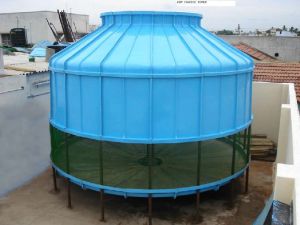
Frp Cooling Towers
FRP cooling towers are very economically operating Cooling Tower, Since there is no fan or electric motor, there is no huge operating or maintenance cost involved in this Cooling Tower and also in Energy efficiency point of view, this is the best Payback Cooling Tower when comparing with other models. Specifications Simply says, in Fan less Cooling Towers the Hot water will be sprayed in the top of the Cooling Tower with spray nozzles into small droplets like mists and the droplets are crossed with the atmospheric wind flow to get the water cooled. Applications : This model Cooling Towers are water saving and pollution free, safety with environmental protection Method / Type : Sound free design. Fanless / Natural Draft : Since no fan, motor and gear box it is low noise Cooling Tower than any other low noise type Cooling Tower. Fan Motor Type : Since fan, motor and gear boxes are used, high noise and vibration. Advantages : FRP cooling towers of other model cooling towers are due to Fan, Motor, Gear box and Drive shaft and its vibrations. Since these models of Cooling Towers are not having Fan, motor, Gear boxes, this equipment has no trouble-some of noise & vibration.
...more
finned tube heat exchangers
Finned Tube Heat Exchangers is a type of heat exchanger design that uses plates and finned chambers to transfer heat between fluids. It is often categorized as a compact heat exchanger to emphasise its relatively high heat transfer surface area to volume ratio. The plate-fin heat exchanger is widely used in many industries, including the aerospace industry for its compact size and lightweight properties, as well as in cryogenics where its ability to facilitate heat transfer with small temperature differences is utilized. A high degree of flexibility is present in plate-fin heat exchanger design as they can operate with any combination of gas, liquid, and two-phase fluids. Heat transfer between multiple process streams is also accommodated, The main four type of fins are: plain, which refer to simple straight-finned triangular or rectangular designs; herringbone, where the fins are placed sideways to provide a zig-zag path; and serrated and perforated which refer to cuts and perforations in the fins to augment flow distribution and improve heat transfer. Specifications : Originally conceived by an Italian mechanic, Paolo Fruncillo. A plate-fin heat exchanger is made of layers of corrugated sheets separated by flat metal plates, typically aluminium, to create a series of finned chambers. Separate hot and cold fluid streams flow through alternating layers of the heat exchanger and are enclosed at the edges by side bars. Heat is transferred from one stream through the fin interface to the separator plate and through the next set of fins into the adjacent fluid. The fins also serve to increase the structural integrity of the heat exchanger and allow it to withstand high pressures while providing an extended surface area for heat transfer. Applications : The cost of Fin heat exchangers is generally higher than conventional heat exchangers due to a higher level of detail required during manufacture. However, these costs can often be outweighed by the cost saving produced by the added heat transfer. Fin heat exchangers are generally applied in industries where the fluids have little chances of fouling. The delicate design as well as the thin channels in the fin heat exchanger make cleaning difficult or impossible. Advantages : High heat transfer efficiency especially in gas treatment Larger heat transfer area Approximately 5 times lighter in weight than that of shell and tube heat exchanger. Able to withstand high pressure
...more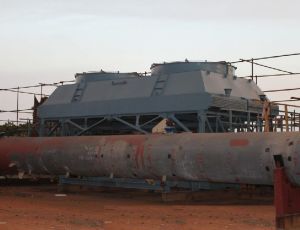
Fin Fan Coolers
The Air Cooled Heat Exchangers are also known as Fin fan Coolers. Since Fins are used in the Cooler it is called as Fin fan Cooler Specifications : The ambient air is used as the cooling media to cool the main hot fluid which is used in tube side. Applications : The finned tubes are having more contact surface. All the tubes used in the coolers are finned tubes. Advantages : This is one of the best closed circuit and water savable cooling system.
...more
Fanless Cooling Tower
Fanless Cooling Towers is a design in which the flow is directed perpendicular to the water. The air continues through the fill and thus past the water flow into an open plenum volume. A fan forces the air out into the atmosphere. Air flow enters one or more vertical faces of the cooling tower. Water flows through the fill by gravity. Specifications Fanless Cooling Towers designs are popularly associated with nuclear power plants. The same kind of cooling towers are often used at large coal-fired power plants. Some instead cool their heat exchangers with lake, river or ocean water. Applications : Fanless Cooling Towers leaves its dissolved salts behind in the bulk of the water which has not been fanless, thus raising the salt concentration in the circulating cooling water. Advantages : Fanless Cooling Towers absorbs heat from the hot process streams which need to be cooled or condensed, and the absorbed heat warms the circulating water.
...more
Dry Cooling Tower
Dry Cooling Towers are nothing but type radiator Cooling. All the heat Transfer areas can be easily approach, the periodical cleaning and maintenance will be very easy and also the replacement period is also more when comparing with other cooling Tower system. Oil/water is cooled by a single heat Exchanger system, cost energy cooling water and maintenance spent can be reduced, various hot media can be cooled simultaneously by the same fan using parts. The tubes are wounded with integral Aluminium or copper wire type fins for increasing the Heat Transfer areas. In this system the core area Heat Transfer area is cooled with a intake cooling Fan at the top with the help, TEFC Electric motor in counter flow method to maximize heat transfer efficiency. The hot media primary will be circulated inside the tubes and the atmospheric air is used as the secondary media to cool the primary media. Specifications Dry Cooling Tower is one of the latest model Cooling Tower. Dry Cooling Tower is specially designed with copper or aluminium finned tube to increase the heat transfer area & these towers are particularly designed for water areas. Applications : Process Engine water or oil is directly taken from the system to Dry Cooling Tower. So the mid-Heat Exchanger is not required. Advantages : Dry Cooling Tower is functioning with Air cooling Technology, there is no needs of excess water evaporative and make up is required to operate the cooling Tower.
...more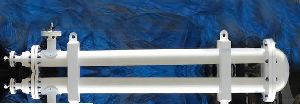
Double Pipe Heat Exchanger
A double pipe heat exchanger, in its simplest form is just one pipe inside another larger pipe. One fluid flows through the inside pipe and the other flows through the annulus between the two pipes. The wall of the inner pipe is the heat transfer surface. The pipes are usually doubled back multiple times as shown in the diagram at the left, in order to make the overall unit more compact. The term ‘hairpin heat exchanger’ is also used for a heat exchanger of the configuration in the diagram. A hairpin heat exchanger may have only one inside pipe, or it may have multiple inside tubes, but it will always have the doubling back feature shown. Types of Double Pipe Heat Exchangers :- 1. Counter flow2. Parallel Flow Heat Exchanger 1. Counter flow:-The main advantage of a hairpin or double pipe heat exchanger is that it can be operated in a true counter flow pattern, To get More Efficiency, In the mean Time, it will give the highest overall heat transfer coefficient for the double pipe heat exchanger design. 2. Parallel Flow:-Parallel Flow double pipe heat exchangers are focused to handle high pressures and temperatures applications. Also we can Achieve High Log mean Temperature using this. 3. Double Pipe Heat Exchanger Design:- Determination of the heat transfer surface area needed for a double pipe heat exchanger design can be done using the basic heat exchanger equation: Q = UA ΔTlm, where: Q is the rate of heat transfer between the two fluids in the heat exchanger in Btu/hr, U is the overall heat transfer coefficient in BTU/hr-ft2-oF,Remove term: A is the heat transfer surface area in ft2, and ΔTlm is the log mean temperature difference in oF, calculated from the inlet and outlet temperatures of both fluids. These parameters in the basic heat exchanger equation are discussed in ‘and they are used in an example in ‘ After determination of the required heat transfer surface area, the diameter and length of the inner pipe can be selected and then the diameter of the outer pipe. Finally, the length of the straight sections and the number of bends can be selected. Specifications : Some heat exchanger manufacturers advertise the availability of finned tubes in a hairpin or double pipe heat exchanger. These would always be longitudinal fins, rather than the more common radial fins used in a crossflow finned tube heat exchanger. Applications : A primary advantage of a hairpin or double pipe heat exchanger is that it can be operated in a true counterflow pattern, which is the most efficient flow pattern. It will give the highest overall heat transfer coefficient for the double pipe heat exchanger design. Advantages : Double pipe heat exchangers can handle high pressures and temperatures well. When they are operating in true counterflow, they can operate with a temperature cross. The cold side outlet temperature is higher than the hot side outlet temperature.
...more
Cross Flow Cooling Tower
Cross flow gravity distributes the water through the nozzles uniformly across the fill material. Cross flow is a design in which the air flow is directed perpendicular to the water flow Air flow enters one or more vertical faces of the cooling tower to meet the fill material. Cross flow of air continues through the fill and thus past the water flow into an open plenum volume. Water flows through the fill by gravity. A distribution or hot water basin consisting of a deep pan with holes or nozzles in its bottom is located near the top of a cross flow tower. Advantages of the cross flow design: Water distribution allows smaller pumps and Non-pressurized spray simplifies variable flow. Lower initial and long-term cost, mostly due to pump requirements.
...more
Counter Flow Cooling Tower
Counter Flow Cooling Tower The air flow is directly opposite to the water flow in counterflow. Gravity distributes the water through the nozzles uniformly across the fill material. Advantages of the counterflow design is Spray water distribution makes the tower more freeze-resistant. Disadvantages of the counterflow design is basically higher initial and long-term cost, and Difficult to use variable water flow, as spray characteristics may be negatively affected.
...more
Coil Type Heat Exchanger
Coil Type Heat Exchanger is nothing but Copper tubes are artificial to special requirements as to dimensional tolerances, finish and tempers for use in condensers and heat exchangers. These copper heat exchanger tubes are normally supplied in straight length in annealed & half hard temper. The copper tubes shaped by are metal industries not only have the stiff tolerances but also have the most dependable dimensions throughout the tube length. The tube surface is clean both inside and outside with no caustic stains. The copper tubes produced by are metal industries are suitable to transfer heat in a wide variety of operating conditions and to refuse to accept decay for the longest period of time possible under the harshest operating circumstances.Coil type exchangers are more efficient than shell and tube exchangers for low flow rates. Due to their simple construction they are low in price and easy to clean on the shell side. Their thermal efficiency approximates that of a true countercurrent flow type exchanger. Condenserors are used for condensation of vapours and cooling of liquids. Condensers are made by fusing number of parallel coils in a glass shell. Coils are made in different diameters using tubes of different bores. Specifications : Copper tubes are important because motors and motor-driven systems account for 43%-46% of all global electricity consumption and 69% of all electricity used by industry. Increasing the mass and cross section of copper in a coil increases the electrical energy efficiency of the motor. Copper motor rotors, a new technology designed for motor applications where energy savings are prime design objectives, are enabling general-purpose induction motors to meet and exceed National Electrical Manufacturers Association (NEMA) premium efficiency standards. Applications : The major applications of copper are in electrical wires (60%), roofing and plumbing (20%) and industrial machinery (15%). Copper is mostly used as a metal, but when a higher hardness is required it is combined with other elements to make an alloy (5% of total use) such as brass and bronze. A small part of copper supply is used in production of compounds for nutritional supplements and fungicides in agriculture. Machining of copper is possible, although it is usually necessary to use an alloy for intricate parts to get good machinability characteristics. Advantages : The electrical properties of copper are exploited in copper wires and devices such as electromagnets. Integrated circuits and printed circuit boards increasingly feature copper in place of aluminium because of its superior electrical conductivity (see Copper interconnect for main article) Heat sinks and heat exchangers use copper as a result of its superior heat dissipation capacity to aluminium. Vacuum tubes, cathode ray tubes. The magnetrons in microwave ovens use copper, as do wave guides for microwave radiation. Copper’s greater conductivity versus other metallic materials enhances the electrical energy efficiency of motors.
...more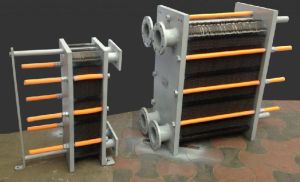
Brazed Plate Heat Exchanger
We are the leading manufacturers of Air heat exchangers in India. Brazed Plate Heat Exchangers represent the most compact, rugged and cost-effective means of transferring heat in many industrial and refrigerant applications. Built from 316 stainless steel with copper brazing materials, they provide exceptional corrosion resistance. The SB-Series features corrugated plates that produce highly turbulent flow in a true counter-current direction. This results in high efficiency and a very compact heat exchanger design. Due to the smaller size and reduced material content, they can be the most economical heat transfer choice.API Heat Transfer Brazed Plate Heat Exchangers are available for process and refrigeration applications. Made from stainless-steel plates and copper or nickel brazing materials, they are suitable for a wide variety of heat exchanger applications. Specifications : The brazed plates form two separate channel systems. The two media assume a true countercurrent flow, completely isolated from each other. This channel configuration is designed to produce high turbulence, promoting maximum heat transfer. Applications : Hydronic heating Domestic hot water heating Radiant heating Snow & ice melting Chilled water cooling Beer & wort chilling Hydraulic oil cooling Outdoor wood furnaces/stoves/boilers and other water to water and liquid to liquid heat transfer applications. Advantages : Flexibility to change plate arrangement and to add or remove plate Optimized heat recovery Easy maintenance and suitable for CIP, plate pack easily accessible No mixing of product High heat transfer coefficients Compact constructions
...more
Aluminium Heat Exchanger
Aluminium Heat Exchangers Manufacturer INDIA A heat exchanger is a piece of equipment built for efficient heat transfer from one medium to another. The media may be separated by a solid wall, so that they never mix, or they may be in direct contact. They are widely used in space heating, refrigeration, air conditioning, power plants, chemical plants, petrochemical plants, petroleum refineries, natural gas processing, and sewage treatment. The classic example of a heat exchanger is found in an internal combustion engine in which a circulating fluid known as engine coolant flows through radiator coils and air flows past the coils, which cools the coolant and heats the incoming air. Cryo-tek -100/AL is a blend of virgin (not recycled) propylene glycol and Hercules exclusive Triple Protection additives designed for use in hydronic heating and cooling closed loop piping systems (including PEX and radiant tube heating systems), ice melt and general heating systems where aluminum heat exchangers are installed. Hercules Triple Protection additives provide outstanding protection against acid corrosion, scale and sedimentation formation in properly maintained systems containing recommended concentrations of cryo-tek Anti-Freeze. Acid neutralizing agent protects by neutralizing corrosive acids.Mineral Deposition Preventative eliminates scale formation on critical heat transfer surfaces, piping systems and equipment. Mineral Sediment Preventative keeps minerals in solution, resisting formation of clusters of mineral salts and preventing particles from precipitating out of solution. Used at recommended levels, all three agents work together to prevent bio film (slime) build-up. Cryo-tek -100/AL may be used in systems fabricated with metal, plastics (except CPVC) and rubber piping, fittings, seals, and other parts. Formulated for the maximum propylene glycol protection directly out of the container. Certified Performance: Freeze Protection Down to -60°F / -51°C, Pumpable down to -70°F / -57°C, and Burst Protection Down to -100°F / -73°C. Cryo-tek -100/AL can be diluted with water for less severe conditions. Specifications : A new generation of very efficient boilers utilizing ALUMINIUM HEAT EXCHANGERS are becoming more popular in today’s marketplace. These new boilers typically heat three times faster than traditional boilers and require a specific, unique blend of anti-freeze specific to protecting against acid corrosion. Applications : Corrosion inhibitors in all cryo-tek products protect against corrosive build-up within the piping loop and are effective with most metals including steel, aluminum and copper. Cryo-tek solutions have a high specific heat and are efficient at transferring heat. As packaged, cryo-tek is non-flammable, odorless, non-irritating, and compatible with Hercules boiler stop leaks. Advantages : Aluminium is the most widely used non-ferrous metal. Global production of aluminium in 2005 was 31.9 million tonnes. It exceeded that of any other metal except iron. Forecast for 2013 is 42–45 million tonnes, driven by rising Chinese output. Aluminium is almost always alloyed, which markedly improves its mechanical properties, especially when tempered. the common aluminium foils and beverage cans are alloys. The main alloying agents are copper, zinc, magnesium, manganese, and silicon The levels of these other metals are in the range of a few percent by weight.
...moreBe first to Rate
Rate ThisOpening Hours